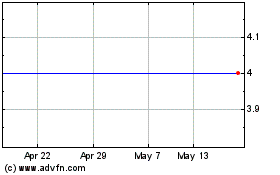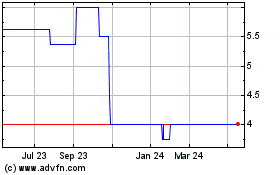Aisi Realty Public Limited Half Yearly Report -11-
September 05 2012 - 2:00AM
UK Regulatory
position if, and only if, there is a currently enforceable legal
right to offset the recognized amounts and there is an intention
to settle on a net basis, or to realise the asset and settle
the liability simultaneously. This is not generally the case
with master netting agreements, and the related assets and liabilities
are presented gross in the consolidated statement of financial
position.
3.24 Earnings and Net Assets Value per share
The Group presents basic and diluted earnings per share (EPS)
and net asset value per share (NAV) for its ordinary shares.
Basic EPS amounts are calculated by dividing net profit for the
year, attributable to ordinary equity holders of the Company
by the weighted average number of ordinary shares outstanding
during the year. Basic NAV amounts are calculated by dividing
net asset value as at year end, attributable to ordinary equity
holders of the Company by the number of ordinary shares outstanding
at the end of the year.
Diluted EPS is calculated by dividing net profit for the year,
attributable to ordinary equity holders of the parent, by the
weighted average number of ordinary shares outstanding during
the year plus the weighted average number of ordinary shares
that would be issued on conversion of all the potentially dilutive
ordinary shares into ordinary shares. Diluted NAV is calculated
by dividing net asset value as at year end, attributable to ordinary
equity holders of the parent with the number of ordinary shares
outstanding at year end plus the number of ordinary shares that
would be issued on conversion of all the potentially dilutive
ordinary shares into ordinary shares.
3.25 Comparative amounts
Where necessary, comparative amounts have been reclassified to
conform to changes in presentation adopted in the current year.
4. Risk management
4.1 Financial risk factors
The Group is exposed to country risk, real estate holding and
development associated risks, market price risk, interest rate
risk, credit risk, liquidity risk, currency risk, other market
price risk, operational risk, compliance risk, litigation risk,
reputation risk, capital risk management and other risks arising
from the financial instruments it holds. The risk management
policies employed by the Group to manage these risks are discussed
below. Financial Risk Management is also described in note 27
of the financial statements.
4.1.1 Operating Country Risks
The Group is exposed to country risk, stemming from the political
and economic environment of every country in which it operates.
4.1.1.1 Ukraine
In recent years, the Ukrainian economy has been characterised
by a number of features that contribute to economic instability,
including a relatively weak banking system providing limited
liquidity to Ukrainian enterprises, significant capital outflows,
and low wages for a large portion of the Ukrainian population.
The implementation of reforms has been partially impeded by lack
of political consensus, controversies over privatisation, the
restructuring of the energy sector, the removal of exemptions
and privileges for certain state-owned enterprises or for certain
industry sectors, the limited extent of cooperation with international
financial institutions and non stable taxing environment.
Although Ukraine has made significant progress in increasing
its gross domestic product, decreasing inflation, stabilising
its currency, increasing real wages and improving its trade balance,
these gains may not be sustainable over the longer term and may
be reversed unless Ukraine undertakes certain important structural
reforms in the near future while continuing to exercise restrictive
monetary policies.
Ukraine's internal debt market remains illiquid and underdeveloped
as compared to markets in most western countries. Unless the
international capital markets or syndicated loan markets open
up to Ukraine, the Government will have to continue to rely to
a significant extent on official or multilateral borrowings to
finance part of the budget deficit, fund its payment obligations
under domestic and international borrowings and support foreign
exchange reserves. These borrowings may be conditioned on Ukraine
satisfying certain requirements, which may include, among other
things, implementation of strategic, institutional and structural
reforms; reduction of overdue tax arrears; absence of increase
of budgetary arrears; improvement of sovereign debt credit ratings;
and reduction of overdue indebtedness for electricity and gas.
Negative developments on these may result in Ukraine not finding
adequate financing which could, in its turn put pressure on Ukraine's
budget and foreign exchange reserves and have a material adverse
effect on the Ukrainian economy as a whole, and thus, on the
Group's business prospects.
Any major adverse changes in Ukraine's relations with Russia,
in particular any such changes adversely affecting supplies of
energy resources from Russia to Ukraine and/or Ukraine's revenues
derived from transit charges for Russian oil and gas, would likely
have negative effects on certain sectors of the Ukrainian economy
which could under certain conditions affect the Group's business.
The Ukrainian legal system has also been developing to support
this market-based economy. Ukraine's legal system is, however,
in transition and is, therefore, subject to greater risks and
uncertainties than a more mature legal system. In particular,
risks associated with the Ukrainian legal system include, but
are not limited to:
(i) inconsistencies between and among the Constitution of Ukraine
and various laws, presidential decrees, governmental, ministerial
and local orders, decisions, resolutions and other acts;
(ii) provisions in the laws and regulations that are ambiguously
worded or lack specificity and thereby raise difficulties when
implemented or interpreted;
(iii) difficulty in predicting the outcome of judicial application
of Ukrainian legislation; and
(iv) the fact that not all Ukrainian resolutions, orders and
decrees and other similar acts are readily available to the public
or available in understandably organised form.
Furthermore, several fundamental Ukrainian laws either have only
relatively recently become effective or are still pending hearing
or adoption by the Parliament. The recent origin of much of Ukrainian
legislation, the lack of consensus about the scope, content and
pace of economic and political reform and the rapid evolution
of the Ukrainian legal system in ways that may not always coincide
with market developments, place the enforceability and underlying
constitutionality of laws in doubt, and result in ambiguities,
inconsistencies and anomalies.
In addition, Ukrainian legislation often contemplates implementing
regulations. Often such implementing regulations have either
not yet been promulgated, leaving substantial gaps in the regulatory
infrastructure, or have been promulgated with substantial deviation
from the principal rules and conditions imposed by the respective
legislation, which results in a lack of clarity and growing conflicts
between companies and regulatory authorities.
Tax laws are changing and compared to more developed market economies
are in a non mature level thus creating often an unclear tax
environment of unusual complexity. This particularly affects
negatively the ability of the Group to recuperate VAT paid and/or
to utilize operating losses as a carry forward tax shield.
Emerging economies such as Ukraine's are subject to rapid change
and the information set out in these financial statements may
become outdated relatively quickly.
4.1.2 Risks associated with property holding
Several factors may affect the economic performance and value
of the Group's properties, including:
* risks associated with construction activity at the
properties, including delays, the imposition of liens
and defects in workmanship;
* the ability to collect rent from tenants, on a timely
basis or at all;
* the amount of rent and the terms on which lease
renewals and new leases are agreed being less
favourable than current leases;
* cyclical fluctuations in the property market
generally;
* local conditions such as an oversupply of similar
properties or a reduction in demand for the
properties;
* the attractiveness of the property to tenants or
residential purchasers;
* decreases in capital valuations of property;
* changes in availability and costs of financing, which
may affect the sale or refinancing of properties;
* covenants, conditions, restrictions and easements
relating to the properties;
* changes in governmental legislation and regulations,
including but not limited to designated use,
allocation, environmental usage, taxation and
insurance;
* the risk of bad or unmarketable title due to failure
to register or perfect our interests or the existence
of prior claims, encumbrances or charges of which we
may be unaware at the time of purchase;
* the possibility of occupants in the properties,
whether squatters or those with legitimate claims to
take possession;
* the ability to pay for adequate maintenance,
insurance and other operating costs, including taxes,
which could increase over time; and
* terrorism and acts of nature, such as earthquakes and
floods that may damage the properties.
Secure Property Developm... (LSE:SPDI)
Historical Stock Chart
From Jun 2024 to Jul 2024

Secure Property Developm... (LSE:SPDI)
Historical Stock Chart
From Jul 2023 to Jul 2024
